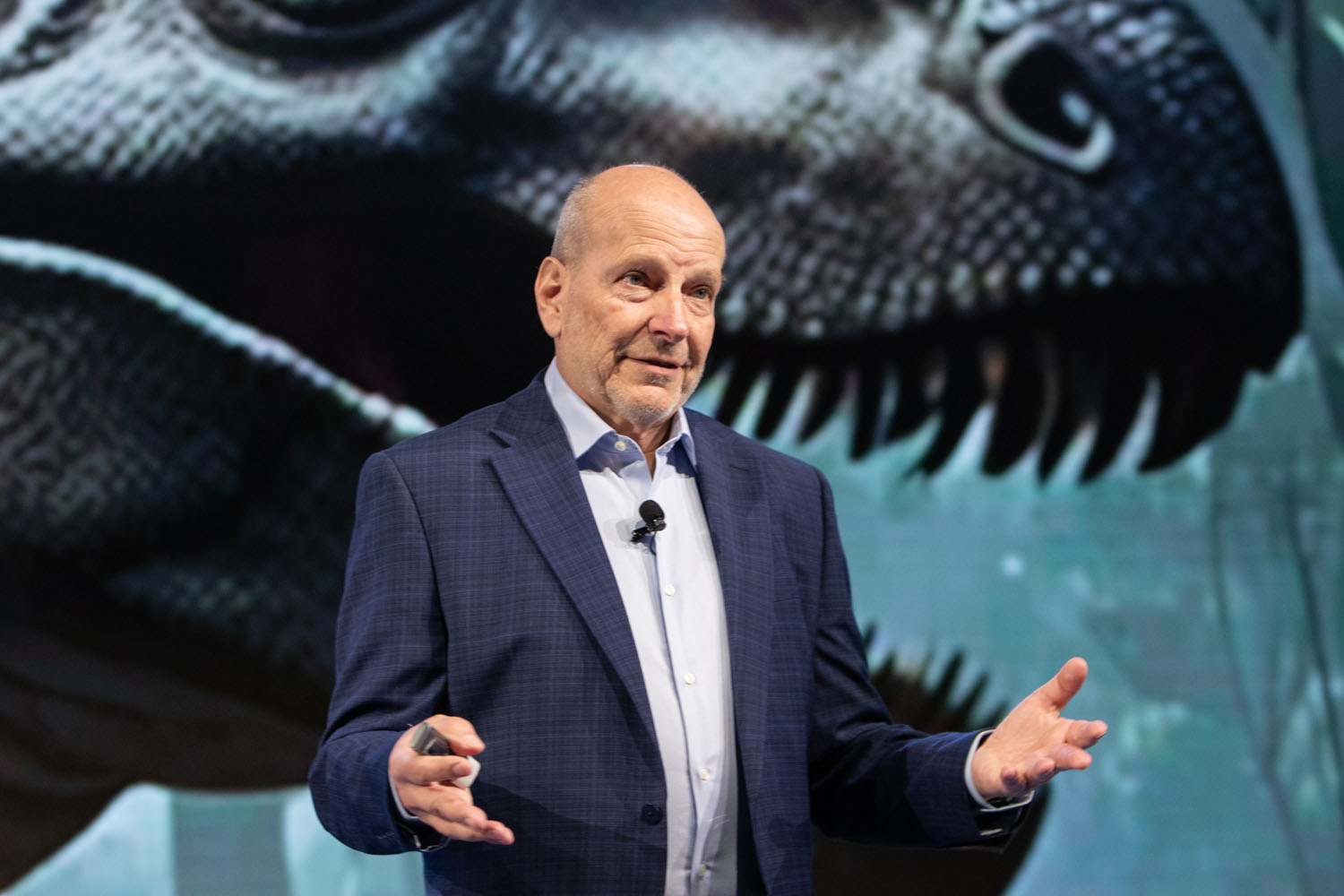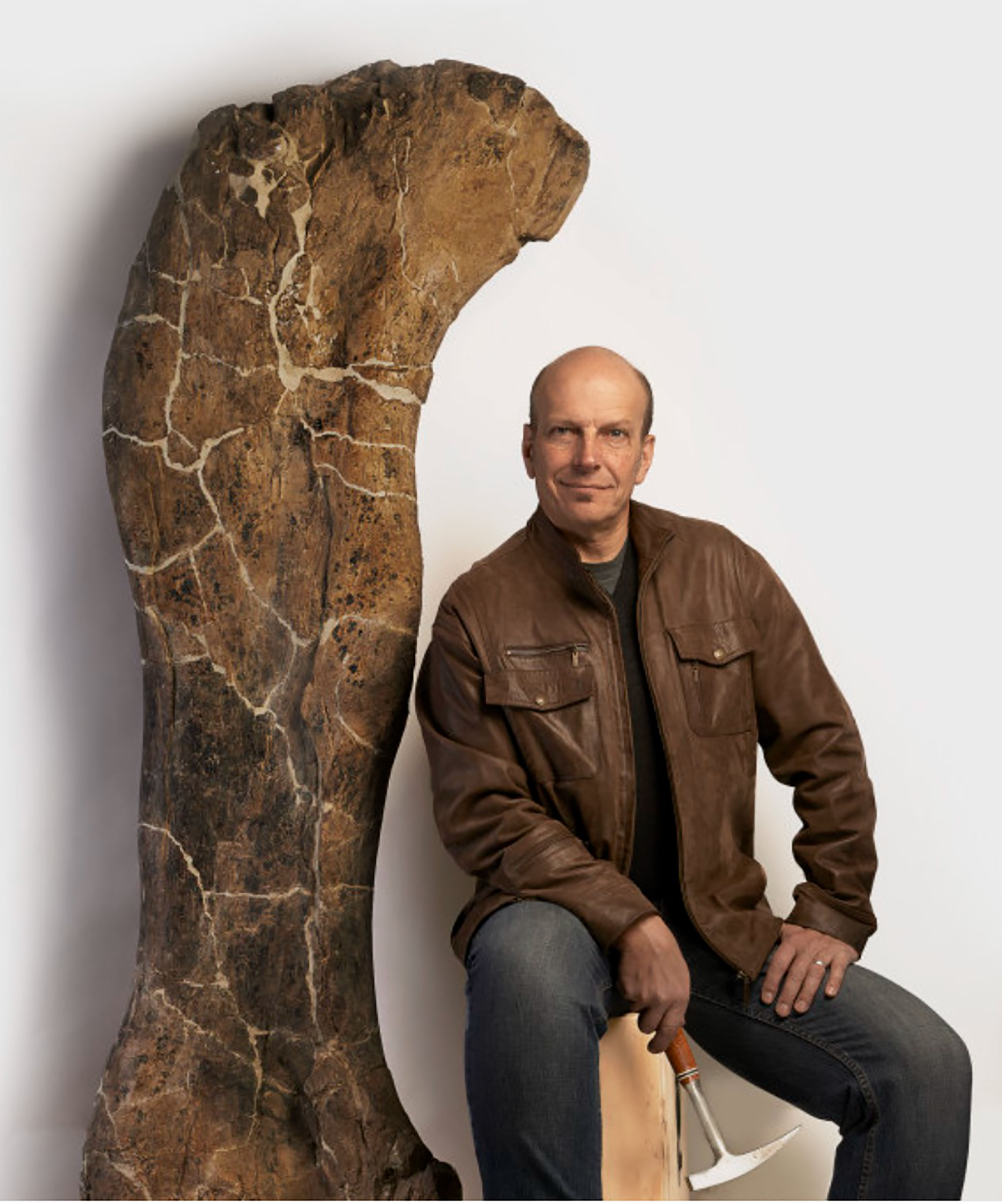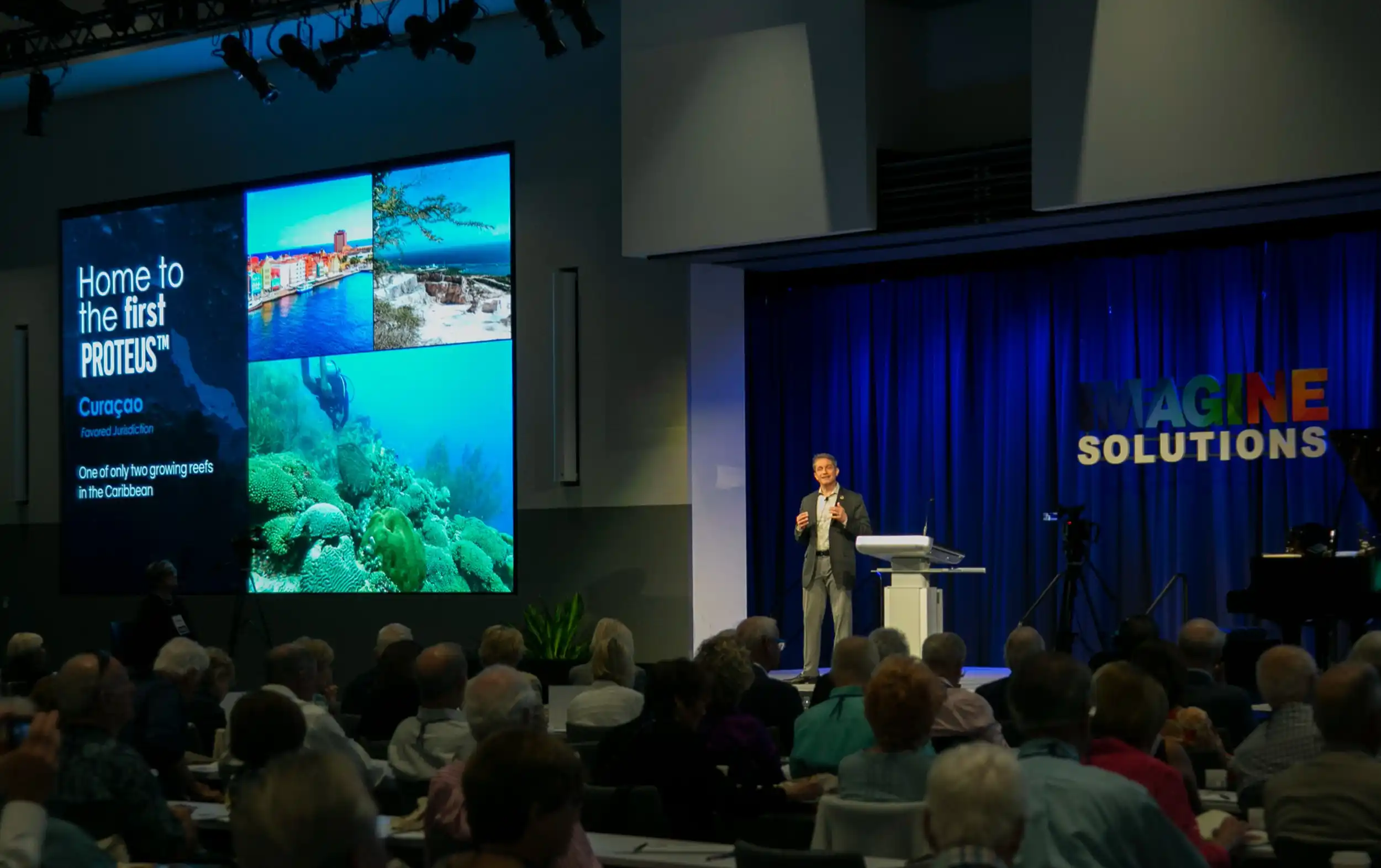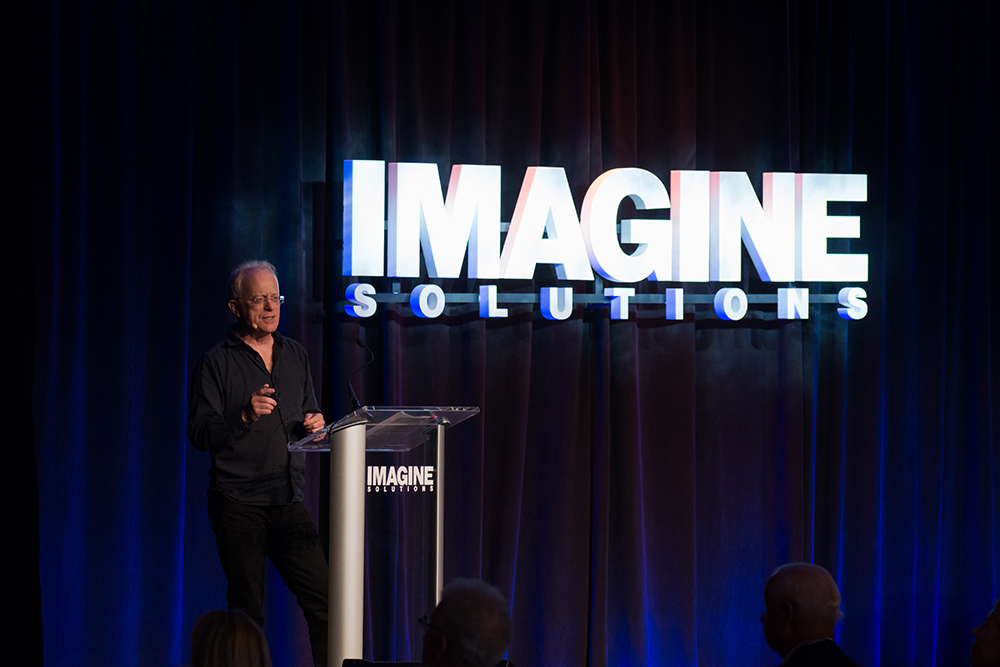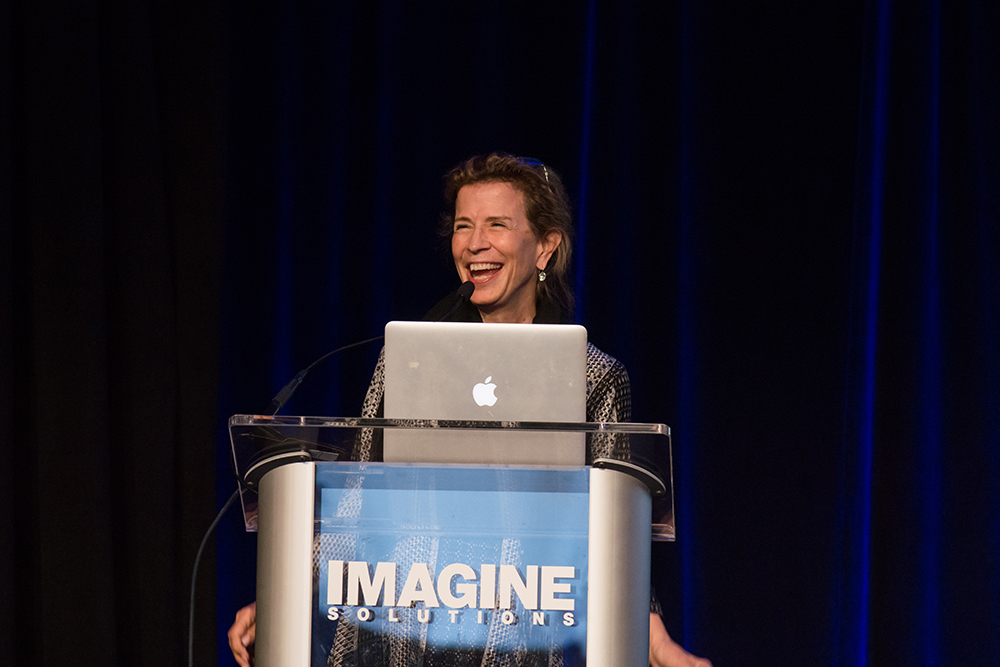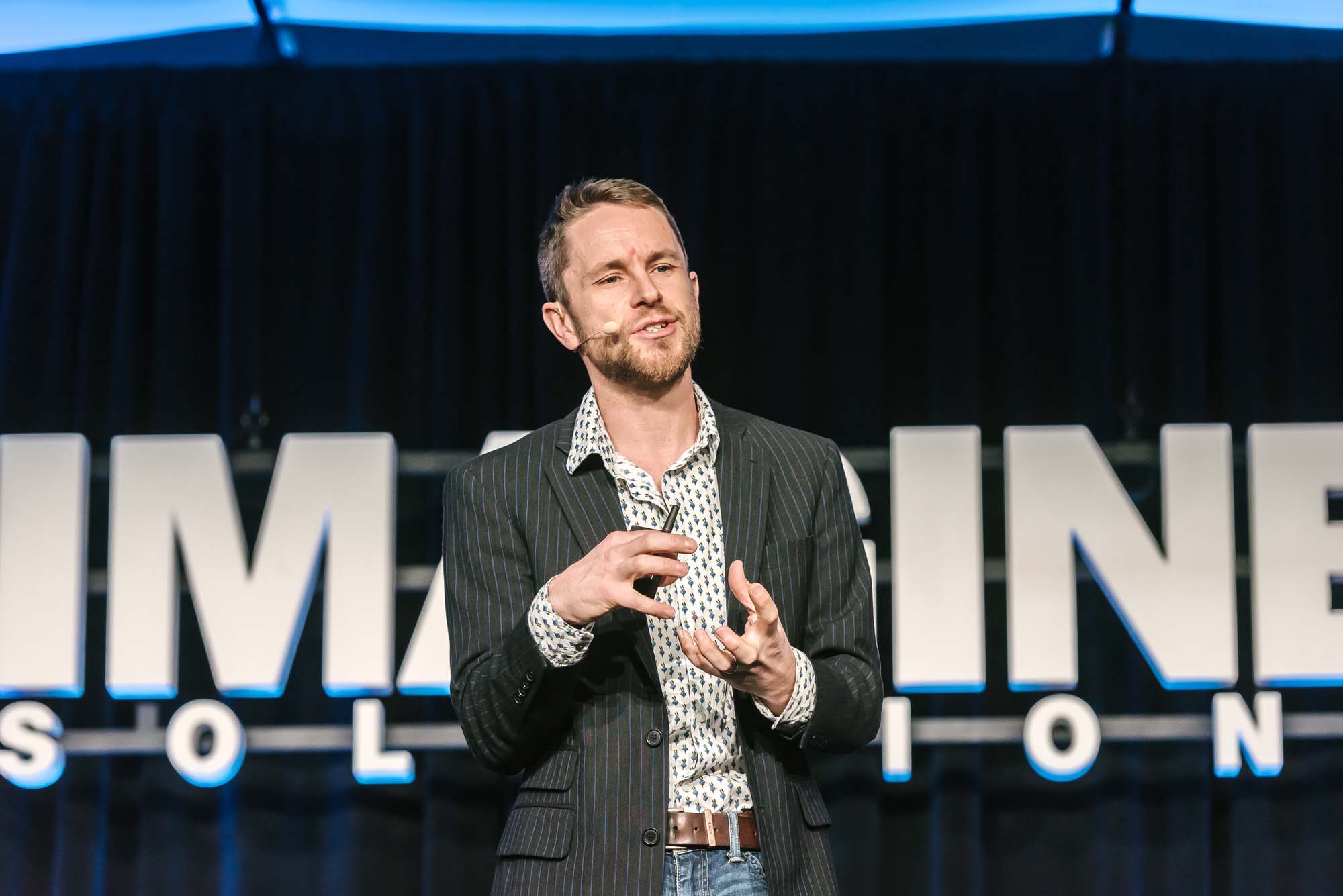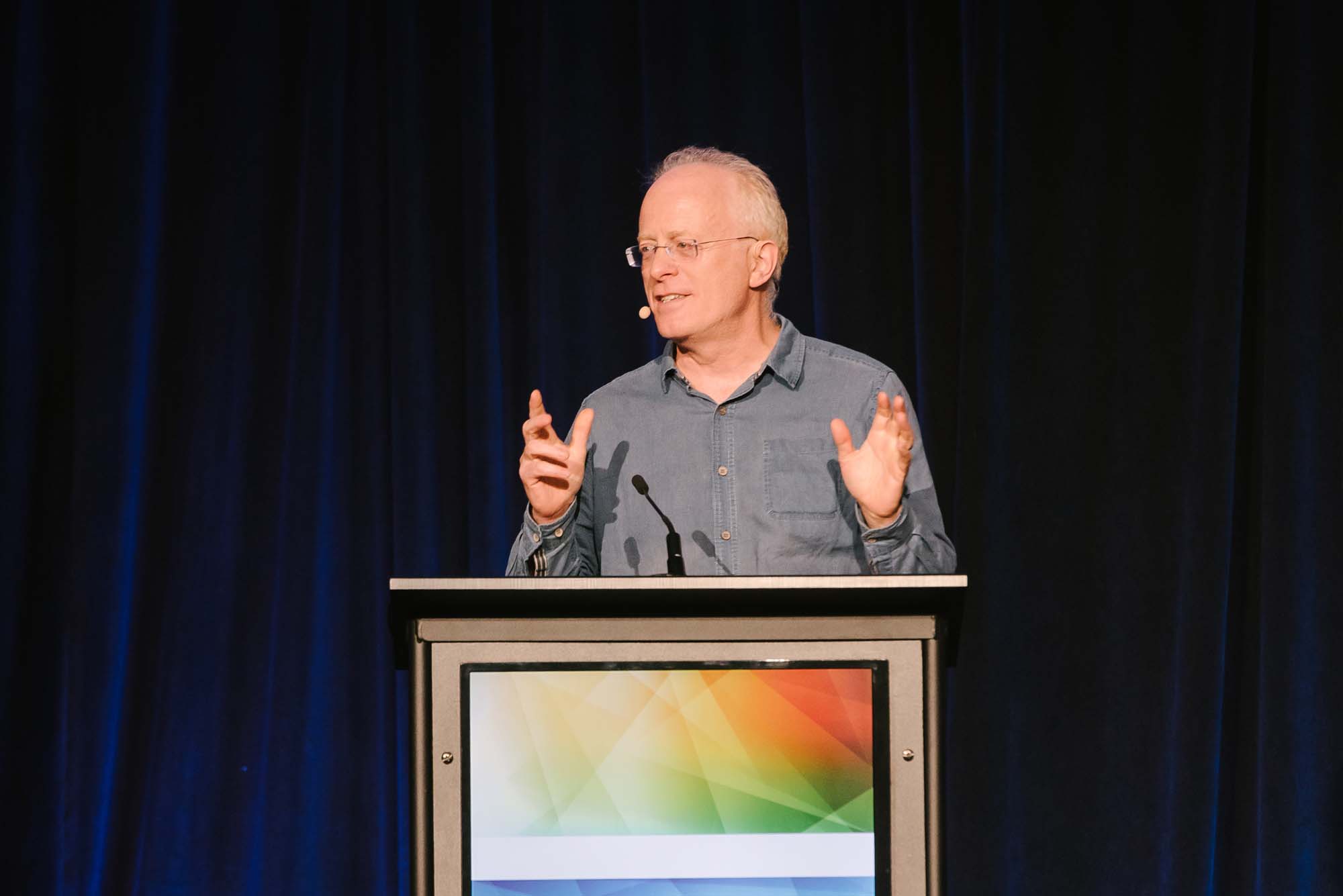Ken Lacovara
With a sense of wonder and urgency, paleontologist Ken Lacovara took the audience on a journey through deep time, revealing how studying Earth’s ancient past can inform our future. Best known for discovering some of the world’s largest dinosaurs, Lacovara used these awe-inspiring creatures to illustrate the fragility and resilience of life. His message was clear: understanding our planet’s evolutionary story is essential to confronting today’s environmental challenges. Equal parts thrilling science and call to action, his talk was unforgettable.
00.13
we're going to return to our theme of the day which is one day of big ideas and our first speaker is accustomed to dealing with big things and I mean really big things big as in discovering the two largest dinosaurs ever ken Lakavara is a paleontologist an explorer an author he's honored as explorer of the year by the Explorers Club he has won numerous medals and awards he's been featured three times in Discovery Magazine's top 100 stories and he is currently developing a $100 million or thereabouts fossil museum and park in of all places New Jersey which is apparently who knew a hot bed of dinosaur finds of all things they're all
01.00
over there near exit 8 off the turnike I'm told so anyhow ladies and gentlemen let's go big with Ken Lakavara where do we get our information not from the future we do not have access to the future nobody remembers the future nobody can do experiments in the future the future is a dark scrim always racing just before us always concealing the way the world will dispose of our hopes and prayers and dreams and desires and the present present is nothing it's the finest wisp of time the present always gives way to the past the sentence I am speaking now is already in your past so what do we have we have the past and all of our information comes from
02.01
the past and the further back you look the further ahead you can see i began my career working in North Africa in the Baharia oasis of Egypt i went there with some colleagues from the University of Pennsylvania to recover the the fabled lost dinosaurs of Egypt these are four species of dinosaurs that were discovered about 100 years before uh brought to the Bavarian Museum of Paleontology in Munich and destroyed in April of 1944 we went back to recover those lost species i found the quarry i found the German newsprint and the sardine cans and the burlap and plaster but we did not find a single bone of those species but in the process of looking we found this that's a giant humorous a giant upper armbbone and over two field seasons we excavated a a collection of bones from this particular individual we would jacket the bones in burlap and plaster to transport them out of the
03.00
desert and it turned out to be the world's second largest dinosaur which I named paralotitan which means tidal giant i moved on to the Gobi Desert with a group of colleagues including some Chinese colleagues and there we discovered this bizarre creature a 12-oot tall fully feathered dinosaur with a beak and these Edward Scissor Hands kind of claws a true nightmare of a creature we named this Suosaurus and then with another group of Chinese colleagues we went to the foothills of the Himalayas near the Taklamakan Desert where our group discovered more than a hundred specimens of this 95year-old bird that filled a 30 million-year gap in the evolutionary history of birds 911 had happened and it became difficult to get back to northern Africa so I set my sights on southernmost Patagonia Find Delm Mundo the end of the
04.00
world and there I found this bone uh that's a femur that is 2.2 meters long or 7 foot one inch long now that bone was isolated we dug and dug and didn't find another one of that individual we found some other bones that field season it was really hard field season i had to raft down a glacial stream to get to the site and then I hired these gauchos to help us drag the plastercovered bones out of the desert like this and so it was a tantalizing result and I was hungry to get back there for more i went back the next year the next field season and immediately started finding giant dinosaur bones only this time not isolated this bone was connected to 145 other bones of a giant planteating dinosaur and eventually the quarry came to look like this and you can see the the tail of that great beast wrapping around me there i spent uh over a year of my life living in that tent in that location i ate a year's worth of dinners
05.02
in that muddy ditch there at the end of the field season I would go into town four hours away and get this rickety old front end loader and use it to extract the very heavy plaster jacketed bones from our quarry we ended up taking 16 tons of fossils out of this location got them back to my lab in the United States had a group of dozens of dozens of people we studied them for over five years and it turned out to be a new species of dinosaur that I named dreadnotus because if you are 85 ft long if you are two and a half stories at the shoulder if you are if you are the mass of 13 bull African elephants the mass of nine T-Rex or 10 tons heavier than a Boeing 737 what have you to fear except perhaps gravity so the name Dreadnaugh means fears nothing now Dreadnotus has kind of
06.02
entered the popular zeitgeist which has been a lot of fun here's Dreadnotis in the last Jurassic World movie uh I was at home minding my business watching the Olympics and Dreadnotis appears in a in an advertisement with Shawn White the snowboarder uh Dreadnotus is a beer i approve and Mattel has made a suitably huge five- foot long dreadnaught toy it's been in the uh David Atenboroough documentary Prehistoric Planet on Apple TV and then National Geographic did a really great job of taking my field notes and reconstructing the dreadnotus quarry digitally giving me really the first time to see all the bones at the same time all laid out as they were now when paleontologists and geologists first realized that dinosaurs were a thing in the middle part of the 19th century they could see that they were here at one moment and they persisted for some interval and then poof they were gone and nobody had any
07.02
idea why and crackpot theories abounded and then in 1980 Walter and Louise Alvarez proposed an idea that maybe it was a comet or an asteroid that wiped out the dinosaurs and paleontologists hated this idea because they did not want this enduring mystery of our field solved by a couple of outsiders and they would say "Well okay where's the crater?" Well the crater was discovered and published in 1991 actually petroleum companies knew about it in the 70s but they didn't tell anybody um so it's off the Yucatan Peninsula it's 110 miles across by 12 miles deep so now we have kind of this murder mystery of what happened to the dinosaurs we have the theory of the crime we have the smoking gun and I'm not a lawyer but I have watched LA law and I believe you can't take a murder case to trial unless you have the bodies and so a worldwide search starts
08.00
for this extinction layer for the bodies and I look for it myself in North Africa and South America and Asia and Montana and Wyoming and Utah and finally I found what I was looking for in this pit behind the Lowe's in New Jersey a place in which over the last 17 years my crew and myself have excavated over a 100,000 fossils representing over a 100 species each of these individuals a literal victim of the asteroid strike that took place 1500 miles from New Jersey if you could lay out all the fossils like we did for this documentary this is what it would look like if you had X-ray vision into that extinction layer so now that brings this murder mystery kind of full circle what's great about this site is not only do we have this research layer that obviously we protect and curate very
09.02
carefully but above that from the moments just after the dinosaurs we have a layer that's still full of fossils and we can let the public come in and collect from those layers and every kid every grown-up that goes to this site who's not afraid to get their hands dirty and who tries a little bit finds a 66 million year old fossil with their own hands and we let them take it home and that becomes just a transformational moment when those kids make that connection between themselves and the earth's deep past what's really happening is that they have made a legitimate discovery they are seeing something that no human has ever seen before they know a little something that no human has ever known before and at that moment they become explorers real explorers and that's an addicting feeling and then they want to know what's there what's there what's there what's over that hill and the next hill and on that continent and on that planet and in the process we are inculcating them with the scientific method a way to receive and process information in a rational way and once that's the way you think
10.03
that's the way you think and then you can go on and apply that to business and medicine and engineering and all the things the world needs so at this point this is a a working quarry i knew I had to find a way to save this place the president of the company told me that hey look things aren't really going to work out for us long term we're going to have to close we're going to have to fill in the quarry and we hope to build a big box store there so I team up with the township and I start thinking about how are we going to save this place how am I going to raise $2 million to buy the property and then what do we do and I thought well maybe I could raise another 300,000 and we will get one of these old farm garages and do a little renovation and we'll have a little classroom on one side and and maybe a little museum on the other side and then I got carried away and so this is the $44,000 square foot $85 million Edelman Fossil Park and
11.00
Museum that I've been working on for 17 years that will open on March 29th and the project turned into the beautiful museum that it is today because of the vision and generosity of Gan and Rick Edelman some of you may know Rick Edelman uh from the financial services sector um and his best-selling uh books and his 30-year running uh radio show on personal finance amazing people uh we hired a great architect Tom Wong who builds museums all over the world and our museum is based on this ancient device called the camera obscura it's a pinhole camera that you can climb into and artists used to use it to project an image of the landscape on the wall they would paint on top of that giving them a different perspective on the world and so this is Tom's original sketch of our building our building is composed of a series of lenses that show us views to the modern views to the
12.01
ancient ways that we can take those two time passages and contextualize them into this present moment like this and so it's just gorgeous architecture and I'm happy to tell you that uh our museum will be one of the largest carbon net zero buildings in the country thank you we have 72 250 ft geothermal wells and we have a contract for the purchase of renewable electricity so I don't have time to tell you about many of the amazing features such as the theater and this overlook and the nature trails and the paleontology themed playground and the store and the cafe and virtual reality and all these other things but I do want to tell you about our galleries we were very fortunate to be able to hire who I think is the world's best paleo artist a gentleman named Gary Stab and in the first gallery we focus on the dinosaurs and other extinct creatures that existed on the
13.01
east coast of the US during the end of the time of the dinosaurs and when people think about dinosaurs they think of you know Patagonia and Montana and the Gobi Desert and places like that but they were all right here on the east coast and we made sure that all five major groups of dinosaurs are represented now dinosaurs are first understood first discovered in Britain in the early 19th century from some very scrappy remains and the remains are so poor that they can't really tell what they are so in 1842 they get that name dinosaur which means terrible lizard they're not lizards at all so that's 1842 fast forward to 1858 and the world's first nearly complete dinosaur skeleton is found in Hadenfield New Jersey and it's this creature right here called Hydrosaurus now what's this dinosaur you can just shout out the name you all know it it's T-Rex of course the world's most famous dinosaur t-rex is not the only
14.00
Tyrannosaur there are about 25 other species of Tyrannosaur and T-Rex was not the first one discovered the first one discovered is a Tyrannosaur called Dryptosaurus found a mile from the Fossil Park Museum in 1866 so the world's first nearly complete dinosaur skeleton found in New Jersey the world's first tyrannosaur lots of other species like you see here found in southern New Jersey truly a hot bed of dino action and then we go into the monstrous seas gallery and what's remarkable about this gallery is that everything you see is something that we found in the quarry 100 yards away in a layer that will literally be 65 ft beneath your feet so all of the fossils that you see in the display cases there are things that were found right there in that layer right under this gallery the star of the show is the mosasaur it's not a dinosaur it's a marine reptile your children's books have lied to you uh this thing is is 55
15.02
ft long imagine a Komodo dragon as long as a school bus with paddles for limbs a six-foot jaw and then they have a second set of teeth at the top of their throat that points backwards to keep you from swimming back out it's a sea monster from the Cretaceous world we go into the Hall of Extinction and Hope where we lay out our uniquely occurring evidence for the world's fifth mass extinction which the dinosaurs and 75% of species perished and then we literally and figuratively turn the corner into the anthropost scene that's the time that we are living in now we have a really cool uh touchless interactive called what's really overheating the planet and visitors can play with different variables and see how they match our temperature history is it changes in the sun changes in the Earth's orbit volcanoes all these other things the answer is no is it greenhouse gases and you can see how it exactly matches our temperature history this is the heartbreaking six extinction wall that fe that features creatures that
16.00
have recently gone extinct at our hand like the passenger pigeon and the dodo and the great ark and the marsupial wolf and creatures that are on the brink of oblivion such as the northern right whale there's only about 400 of them left in the world now so as not to leave you with despair we go into the hope gallery and we have sent film crews all around the world recording eight amazing individuals that are doing incredible things to push back on the climate crisis and to push back on the biodiversity crisis and each of them urges the visitor to act now well how do you do that when you come into the museum and you register you get this RFID tag that we call the explorer key that throws up your own personal page on our website you can keep track of your activities you can acrewue points and level up as a visitor but at the ACT now kiosk you can bookmark local national and global organizations get a list of events get a reading list a viewing list and an action list things that you can do when you're at home away from the museum like plant a pollination garden
17.00
or build a bee hotel or buy an EV or put up solar panels you send us evidence of this you get points added to your your score and you level up as a visitor so you are all set up to make positive change in the world before you walk out the doors of the museum now if you spend your life traveling around the world learning to read the language of the rocks the rocks they start to talk back to you not in a weird way they start to talk back to you and what they always say is they whisper "It didn't have to be this way it didn't have to be this particular way because it's all so contingent." Go back to the Cambrian period we can see this in the Canadian Rockies and you'll see the fossils of this tiny little wormy creature it's called Paia it's a centimeter and a half long now pa lives at the time when we
18.00
see the world's first macro predators that are these big scary things that are a meter across and if you went back to the Cambrian you would never ever put your money on pa it looks delicate and fragile and not terribly successful but it has some really interesting features it has sensory organs concentrated anteriorly it has bilateral symmetry it has a one-way digestive tract which I happen to think is the best kind of digestive tract does that sound like anybody you know that sounds like everybody you know and if pa doesn't make it out of the Cambrian there will never be vertebrate animals there will never be dinosaurs or blue whales or walabbees or hy bats or you or you or you go out to the asteroid belt 4 and a half billion years ago and nudge that asteroid with a piece of popcorn and it doesn't hit the earth 66 million years ago and the dinosaurs that persisted for 165 million years why not another 66 million more and our ancestors these tiny little shrewlike animals that lived
19.01
in the hidden and forgotten recesses of the dinosaur world hoping never to be noticed well that's probably what we'd be doing today go to the southern shores of Pakistan 38 million years ago and kill off this weird wolf-like creature and today there are no whales shift the winds one way or another across North Africa 6 million years ago and humans evolve or do not evolve as forests turn to grasslands or not the contingencies are endless and mind-boggling an infinite kaleidoscope of things and events interacting with one another in ways that we may never fully understand everything matters and the more I contemplate the improbability of my existence and of your existence the more gratitude I feel for being alive for being human and for living in this wondrous age and I want you to think about this imagine if you were a drift in the middle of an ocean with maybe four or
20.02
five other people in a little lonely lifeboat how much would you care for that lifeboat how much would you think about it how much would you fret on it how often would you monitor it how much would you love that lifeboat this is a picture taken by the Apollo 8 astronaut Bill Anders he said "We went all this way to explore the moon and we discovered the Earth." If you go from the bottom of the Mariana's Trench to the top of Mount Everest that's about 12 miles that's the biosphere compared to the Earth it's much much thinner than an eggshell is to an egg it's not much and it's easy to damage we truly live on a little lonely lifeboat in space for us there is no planet B i'm sorry Elon Musk we are not going to put a million people on Mars do
21.00
you know why because Mars is terrible mars doesn't have a breathable atmosphere it doesn't have accessible water it doesn't have nicities like a magnetosphere to protect us from the sun's deadly rays we have an entire continent on Earth Antarctica that we don't even have a breeding population of humans on this is what we have this planet is what we have it's life its hydrosphere its atmosphere and each other and that's all we are ever going to have this precious little lifeboat in space and now what are we doing with our great fortune well in the last 800,000 years atmospheric CO2 has never breached 300 parts per million not when Neanderthalss evolved when we split from those kin not when our species evolved not when the Neanderthalss went extinct 50,000 years ago not when this country was founded and this is what's happening now that's not a mistake in my chart that's the brick wall that we are all
22.00
facing and in terms of populations of animals not species but numbers of individuals if you look at large animals like mammals and reptiles populations are down 69% since 1970 that's shocking why isn't this in the newspaper every day 69% since 1970 if you look at the biomass of mammals on Earth literally get all the mammals and put them on a scale humans and our livestock now account for 96% of the biomass of mammals on Earth all of the wild terrestrial mammals and all of the marine mammals account for 4% wasn't too long ago that this ratio was the reverse extinction is to some degree a natural process and over the last 2 million years the background rate of extinction is for us to lose about nine vertebrate species per century well in the last century we've nine lost nine vertebrate species plus these and
23.00
these and these we can see now through the long lens of geology and paleontology that there have been five previous mass extinctions all caused by climate crisis the last one an instant climate crisis induced by an asteroid impact and now we are propagating the world's six mass extinction this is the fringe limb tree frog from the cloud forest of Panama a remarkable little creature with parasols on its feet allowing it to glide from treetop to treetop across the misty forest canopy this particular individual is named Tffy and Tffy lived in the Atlanta Botanical Garden until the ripe old frog age of 12 when he died and he was the last of his species a species that had a lineage stretching back 3.8 billion years to our microbial forebears a lineage that survived all
24.00
five mass extinctions but it cannot survive us nor could these recently extinct species nor the Mariana fruit bat that went extinct just last year we are now the asteroid but we don't have to be there's still time to act to prevent the worst of it so what do we do well we now have to do the hardest thing that our society has ever done we have to rapidly decarbonize our economy we have to rapidly make space for the natural world we have to do it with very little time and if we have to do the hardest thing that we have done as a society doesn't it follow then that we should try to do the hardest thing that we can do as an individual now I get it everybody has different capabilities and different resources and if you're a a single mom trying to make ends meet well maybe there's not a lot you can do right now but small changes
25.01
add up and voting is a powerful force but if you are a person of means or a person with time or knowledge or a network of people to get things done then I urge you to think about to meditate on to contemplate what's the hardest thing that you can do find that thing and do that thing because we are out of time and the time to act is now thank you very much Ken thank you very much and congratulations on the new museum and exhibition center i I'm sure lots of people here who come from New Jersey or are going to be passing through will go there near Rowan University that's right 20 minutes from Philadelphia please come visit i'll give you a tour ken so much uh well thank you very much for this now I've got the power thank you so much Ken Lagavara ladies and gentlemen

